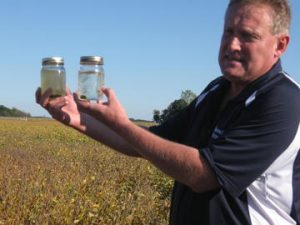In western Ohio, farmers and agricultural educators are making a compelling case that cover crops and no-till will get you more from less: Requiring less fuel, less machinery, fewer chemical inputs and less acreage, these ecological farming practices lead to improved profitability, better soil health, more jobs, improved environmental stewardship and a better quality of life.
Jeff Rasawehr, a Celina, Ohio, farmer who is among those leading by example, estimates he has improved his net profitability by $200 per acre since switching from conventional farming to using cover crops and no-till eight years ago. In addition, Rasawehr has experienced a significant increase in water quality as he shows in the two jars.
“This is a whole different approach,” says Rasawehr, who grows corn, soybeans and wheat on 2,000 acres. “Less of all the things we’ve been told we need to do – less tillage, less chemicals – makes for more profitability, more quality of life.”
On the matter of quality of life, his reasoning is this: By improving his profitability so significantly, he has found he can afford to downsize strategically. This not only gives him less farm work to do, it potentially frees up more acreage for young farmers. “I tell people you don’t need to be farming the whole county to make a decent profit.”
In 2009, Rasawehr received a Sustainable Agriculture Research and Education (SARE) grant to test the role of various cover crop species in nutrient cycling and weed management. Through this experience, he decided to launch a cover crop seed business, Center Seeds, which today employs four full-time staff and others part time (a second business, Sustain Seeds, services gardeners). This year, Center Seeds sold seeds and offered management information for 30,000 acres nationwide, and Rasawehr expects business to increase to 100,000 acres in 2013.
Rasawehr, Ohio State University Extension Educator James Hoorman and others are making a big difference in local watersheds also. Supported by a 2008 SARE grant, Hoorman studied the role of cover crops and no-till in protecting water quality. He found that a rye cover crop can tie up as much as 70 percent of the soluble N and 20 pounds per acre of the soluble P in a manure application.
This matters for the nearby Grand Lake St. Mary’s, which supports a $160 million tourism industry that is in doubt because of algae blooms and hypoxia caused largely by nutrients leaving farms. Through extensive outreach, Hoorman helped boost the use of cover crops in local watersheds to 20,000 acres in 2011, including 9,300 acres in the Grand Lake St. Mary’s watershed, or 21 percent of the watershed. This may be a reason why, in 2011, the lake’s problem with toxic algae showed signs of diminishing, Hoorman says.
This only scratches the surface of the hundreds of research and on-farm demonstration projects SARE has supported on cover crops in the last 25 years. To discover more, and to find the practical tools and guides, visit SARE’s Cover Crops Topic Room.



